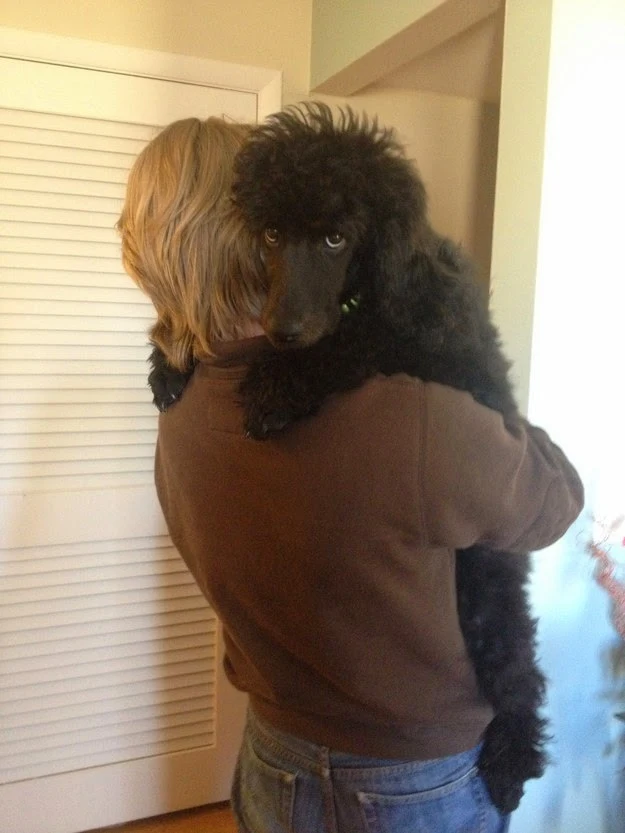Abuse can be active in the form of physical attacks or
punishment, or it can be passive, for example - neglect. In fact, abuse comes in many forms, including:
- Depriving a young animal of its mother through too-early weaning
- Chaining or tying up an animal or forcing it to spend most of its time in a kennel or cage
- Deliberate or thoughtless infliction of chronic stress or pain
- Yelling, hitting or other forms of verbal or physical punishment
- Lack of proper care in feeding, grooming, and attending to health needs
- Partial or complete social isolation; lack of appropriate learning experiences
Was My Adopted Pet Abused? What to Look For
Pets who have been abused are easy to spot if you know the signs. They are very often withdrawn, distrustful, depressed, physically inactive, and unwilling to play. A particularly sensitive abused animal will be off in the corner of the room or in a hiding place, too insecure to even explore her environment.
Often the fear extends to the outdoors and open spaces. Many abused pets are hyper-vigilant, tend to isolate themselves, and make very little noise.
Cats that have not been exposed to people during the first 7 weeks of life never become fully accepting of people and thus rarely make good pets. Cats that have been frightened, mistreated or physically hurt during those seven weeks may develop generalized hostility that sometimes cannot be overcome.
The same is true for dogs, except that the sensitive period usually concludes at around 12-14 weeks.
Creating a Safe Environment for a Previously Abused Pet
If you know or suspect your pet was abused in a former life, the first thing you should do is set some realistic goals – for her and for you.
Take care not to:
1) expect an overnight change in your furry companion, or
2) expect a complete turnaround.
It takes time to help an abused pet learn to look at the world differently and develop trust in humans again. With knowledge, hard work and commitment, a previously abused animal can be transformed into a much-loved member of your family… but she can’t be reborn. It’s important to always remember that.
Here are some general guidelines for creating a safe environment for a previously abused pet:
Make him feel loved and needed - communicate clearly with him.
Create opportunities for him to be successful and build confidence. Feed him a balanced, species-appropriate diet and make sure he gets plenty of physical activity, including 20 to 30 minutes of aerobic exercise each day. The form of exercise may need to be adapted so your pet feels safe.
Additional Steps to Stabilize Your Pet in a New Environment.
Spend some quiet time each day with your new pet. Pick a room both of you are comfortable in, bring a supply of irresistible treats, and close the door behind you. Read a book or engage in some other quiet activity, and every few minutes put a treat near your pet.
Any interaction he has with you or the treat gets rewarded with another treat. When he snatches up the treat or makes even the smallest move in your direction, consider it progress.
Make time for these quiet one-on-ones with your pet each day to build his confidence and trust in you. Let him set the pace. Don’t try to rush things.
Make time for these quiet one-on-ones with your pet each day to build his confidence and trust in you. Let him set the pace. Don’t try to rush things.
If your dog or cat is fearful of unfamiliar people or other animals.
Protect her from forced interactions with them. There may come a time when she can better tolerate such exchanges, but it’s counterproductive to force them on her before she’s ready.
Dr. Dodman also recommends clicker training to build your pet’s confidence. His theory is that clicker training empowers your pet because she has the opportunity to find a way to make you click and thus receive a reward.
When your pet is well along the healing path you’ve laid out for him, it’s time to initiate rehabilitation in the form of desensitization. Dr. Dodman calls desensitization “the behavioral equivalent of homeopathy.” It involves introducing a little bit of what bothers your pet, gradually and under close supervision.
Dr. Nicholas H. Dodman (one of the world's most noted and celebrated veterinary behaviorists) suggests engaging in a “reverse dominance” program, “in which your pet has everything he wants and needs for free. Do not make him work for food, praise, toys or your attention. These should always be available at no cost.”
Dr. Dodman also recommends clicker training to build your pet’s confidence. His theory is that clicker training empowers your pet because she has the opportunity to find a way to make you click and thus receive a reward.
After Stabilization Comes Desensitization
When your pet is well along the healing path you’ve laid out for him, it’s time to initiate rehabilitation in the form of desensitization. Dr. Dodman calls desensitization “the behavioral equivalent of homeopathy.” It involves introducing a little bit of what bothers your pet, gradually and under close supervision.
Many abused animals have behavior issues that may not be immediately apparent. If notable issues continue to surface or you’re having trouble helping your pet make the positive changes you’d hoped for, consider working with a veterinary behaviorist.
Additionally, working with a holistic practitioner that can suggest appropriate homeopathics, flower essences, and essential oil blends, may help facilitate positive feelings, emotions, and behavior changes sooner than expected.
With reference to training, as ethologist Konrad Lorenz once said, "Art and science aren't enough - patience is the basic stuff." This is especially true when it comes to rehabilitating formerly abused animals.
With reference to training, as ethologist Konrad Lorenz once said, "Art and science aren't enough - patience is the basic stuff." This is especially true when it comes to rehabilitating formerly abused animals.
Such animals present the greatest challenge, because they are not blank slates for inscription but rather have already been exposed to un-erasable unfortunate learning.
However, this is not to say that amazing turnarounds cannot be achieved - for they can - only that trainers must work hard with such pets to superimpose new learning that will submerge earlier adverse learning experiences.
Given the right setting and the right owner, many dogs and cats do have the ability to overcome past abusive situations and go on to live full and happy lives.
Given the right setting and the right owner, many dogs and cats do have the ability to overcome past abusive situations and go on to live full and happy lives.
It’s important to feel hopeful, because wonderful turnarounds do happen, and there’s nothing more gratifying.









.jpg)


